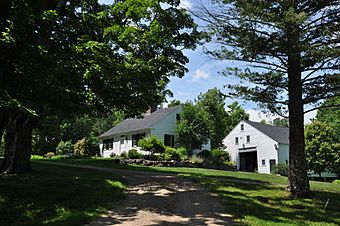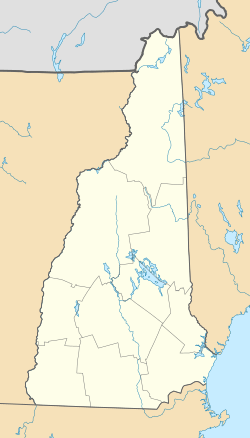Beede Farm facts for kids
Quick facts for kids |
|
|
Beede Farm
|
|
 |
|
| Location | 178 Mill Bridge Road, Sandwich, New Hampshire |
|---|---|
| Area | 303 acres (123 ha) |
| Built | c. 1830 |
| NRHP reference No. | 12000502 |
| Added to NRHP | August 15, 2012 |
Beede Farm is a very old farm and summer home located at 178 Mill Bridge Road in Sandwich, New Hampshire. The main farmhouse was built around 1830 by John Beede. His uncle, Daniel Beede, helped plan out much of the town of Sandwich.
This large property covers about 303 acres (123 hectares) and even has a family cemetery. In 1938, the farm was changed into a summer estate. Because of its history, Beede Farm was added to the National Register of Historic Places in 2012. This list includes important places in American history.
Contents
Exploring Beede Farm's History
Beede Farm is found in a quiet, countryside area in the southwestern part of Sandwich. It covers a large piece of land on both sides of Mill Bridge Road. This road is just south of New Hampshire Route 113.
What Does Beede Farm Look Like?
About 11 acres (4.5 hectares) of the farm are open fields. The rest of the property is covered in forests. The main farm buildings, including the house and a barn, are on the west side of Mill Bridge Road. They sit on about 3 acres (1.2 hectares) of land.
Other interesting parts of the farm include the Beede family cemetery. There is also a cellar hole, which is where an even older house likely stood.
Who Lived at Beede Farm?
The land for Beede Farm was first bought by Thomas Beede sometime between 1771 and 1782. Thomas was the brother of Sandwich's first land surveyor. His son, John Beede, took over the property in 1782. John probably built the current farmhouse around 1830. It replaced an earlier house that might have been on the cellar hole site.
The Beede family owned this farm until 1938. For many years, it was a typical farm for the Lakes Region of New Hampshire. At its biggest, the farm was over 400 acres (162 hectares) and reached all the way to Squam Lake.
In the early 1900s, a part of the farm was used by Camp Hale. This was a summer camp for boys. Beede Farm helped the camp by providing milk and other farm products.
How Beede Farm Changed Over Time
In 1938, the Parsons family bought Beede Farm. They updated the house to look like it would have in its original time period. This was a popular style of renovation back then.
Today, the land around the farm is protected. It has a special agreement called a "perpetual conservation easement." This means the land will stay natural and undeveloped forever.



